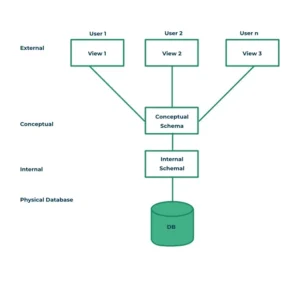3-Tier Architecture in DBMS
The 3-tier architecture of a Database Management System (DBMS) is a logical structure that separates the database system into three distinct levels: external, conceptual, and internal. This layered design ensures data independence, security, and better management by separating the user interface from data storage and organization.
1. External Level (View Level)
- This is the topmost layer and is closest to the end-users.
- It defines how individual users or user groups view the data in the system.
- Each user can have a customized view, meaning they see only the data relevant to their role.
- It hides implementation details, such as data format, structure, and storage location.
Example: A salesperson might only see customer and sales data, while an HR officer only views employee information.
2. Conceptual Level (Logical Level)
- The middle layer that provides a unified view of the entire database for the organization.
- It defines the structure of all the data stored in the database — the tables, relationships, constraints, and keys — but not how it is physically stored.
- This level is responsible for ensuring data integrity, consistency, and enforcing business rules.
Key functions include:
- Defining entities and relationships
- Mapping user views to data models
- Managing security and access at a logical level
3. Internal Level (Physical Level)
- This is the lowest layer, dealing with the physical storage of data on hardware.
- It defines how the data is actually stored in the database — files, indexes, access paths, and compression methods.
- The focus here is on performance optimization, efficient data retrieval, and storage management.
Important aspects include:
- Storage allocation
- File organization (e.g., heap, sequential, hashed)
- Data compression and encryption techniques
Benefits of 3-Tier Architecture
Data Independence: Changes in one layer (e.g., how data is stored) do not affect other layers.
Security and Privacy: Each user sees only the data relevant to them at the external level.
Simplified Management: Administrators and developers can work on their respective levels without disturbing others.
Scalability: Helps manage complex databases more easily by separating concerns.
Conclusion
The 3-tier architecture is a foundational concept in DBMS design. It promotes better organization, data security, and system scalability by separating how users interact with data, how the data is logically organized, and how it is physically stored. This abstraction makes database systems more flexible and manageable in real-world applications.
